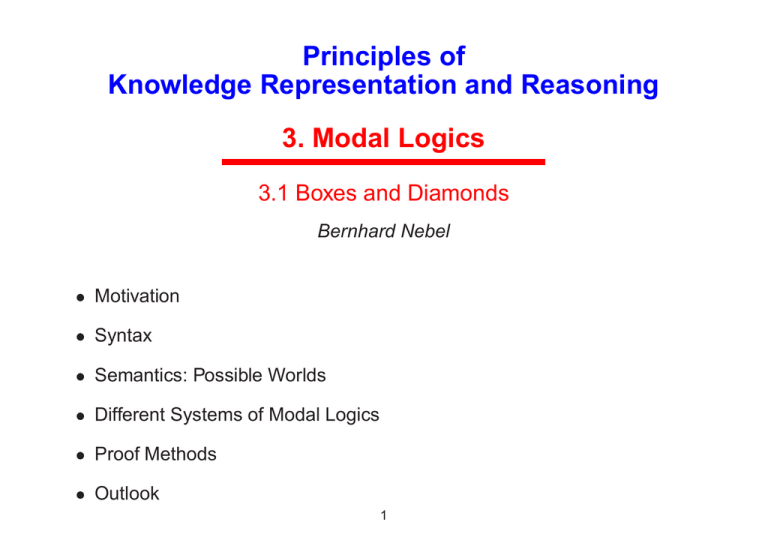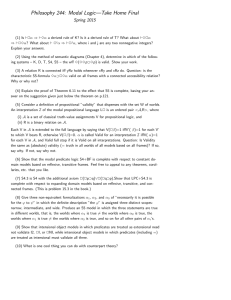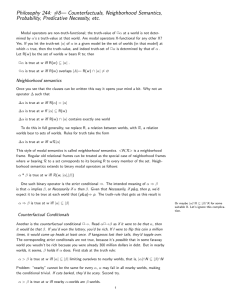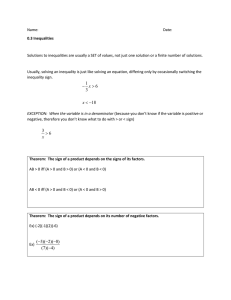Motivation for Modal Logics
advertisement

Principles of
Knowledge Representation and Reasoning
3. Modal Logics
3.1 Boxes and Diamonds
Bernhard Nebel
Motivation
Syntax
Semantics: Possible Worlds
Different Systems of Modal Logics
Proof Methods
Outlook
1
Motivation for Studying Modal Logics
;
!
!
Some KR formalisms can be understood as (fragments of) a
propositional modal logic
Complexity and decidability results can be re-used
Algorithms/proof methods can be re-used
Motivation for introducing modal logic as an independent topic
Will be used for the qualitative spatial representation formalism RCC8
Another application will be description logics
2
Motivation for Modal Logics
Often, we want to state something where we have an “embedded
proposition”:
John believes that theory is nonsense
I know that 210
= 1024
Reasoning with embedded propositions:
!
John believes that theory is nonsense
John believes that if theory is nonsense then theory is dispensable
This implies (assuming belief is closed under modus ponens):
;
John believes that theory is dispensable
; How to formalize this?
3
Syntax
Propositional logic + two new unary operators: 2; 3 (Box & Diamond):
'
! :::
j 2'
j 3'
classical propositional formula
0
Box
0
Diamond
2 and 3 have the same operator precedence as :. Some possible readings
of 2':
Necessarily ' (alethic)
Always ' (temporal)
Make ' true! (deontic)
Agent A believes ' (doxastic)
Agent A knows ' (epistemic)
; different formalizations for different intended
readings
4
Truth Functional Semantics?
Could it be possible to define the meaning of 2' truth functionally, i.e.
by referring to the truth value of ' only?
Trial for the necessity interpretation:
Æ
If ' is false, then 2' should be false.
Æ
If ' is true, then . . .
;
;
. . . 2' should be true ; 2 is the identity function
. . . 2' should be false ; 2' is identical to falsity
Note: There are only 4 different unary Boolean functions.
5
Semantics: The Idea
In classical propositional logic, formulae are interpreted over single
interpretations and are evaluated to true or false.
In modal logics one considers always sets of such interpretations: possible
worlds (physically possible, conceivable, . . . )
Main idea:
Consider a world (interpretation) w and a set of worlds W , which are
possible with respect to w
A classical formula (with no modal operators) ' is true relative to (w; W )
iff ' is true in w
2' is true relative to (w; W ) iff ' is true in all worlds in W
3' is true relative to (w; W ) iff ' is true in one world in W
6
Semantics: An Example
current
world
possible
worlds
a
b
a
b
a
b
a
b
:
:
:
w
Examples:
W
a ^ :b is true relative to (w; W ).
2a is not true relative to (w; W ).
2(a _ b) is true relative to (w; W ).
Question: How shall we evaluate modal formulae in w
; for each world, we specify the possible worlds
; frames
7
2 W?
Frames, Interpretations, and Worlds
A frame is a pair F = hW; Ri, where W is a non-empty set (of worlds) and
R W W (the accessibility relation).
For (w; v ) 2 R we write also wRv .We say that v is an R-successor of w and
that v is reachable (or R-reachable) from w.
A ()-interpretation (or model) based on the frame F = hW; Ri is a triple
I = hW; R; i, where is a function from worlds to truth assignments:
: W
! ( ! fT; F g)
8
Semantics: Truth in one World
A formula ' is true in world w of an interpretation I
following conditions:
I ; w j= a
I ; w j= >
I ; w 6j= ?
I ; w j= :'
I ; w j= ' ^
I ; w j= ' _
I ; w j= ' !
I ; w j= ' $
I ; w j= 2'
I ; w j= 3'
= hW; R; i under the
iff (w)(a) = T
iff
iff
iff
iff
iff
iff
iff
I ; w 6j= '
I ; w j= ' and I ; w j=
I ; w j= ' or I ; w j=
if I ; w j= '; then I ; w j=
I ; w j= '; if and only if I ; w j=
I ; u j= ' for all u s.t. wRu
I ; u j= ' for one u s.t. wRu
9
Satisfiability and Validity
A formula ' is called satisfiable in an interpretation I (or in a frame F , or in
a class of frames C ) if there exists a world in I (or an interpretation I based
on F , or an interpretation I based on a frame contained in the class C ,
respectively) such that I ; w j= '.
A formula ' is called true in an interpretation I (symbolically I
true in all worlds of I .
j= ') if ' is
A formula ' is called valid in a frame F or F -valid (symbolically F
is true in all interpretations based on F .
j= ') if '
A formula ' is called valid in a class of frames C or C -valid (symbolically
C j= ') if F j= ' for all F 2 C .
K is the class of all frames – named after Kripke, who invented this semantics.
10
Validity: Some Examples
' _ :';
2(' _ :');
2', if ' is a classical tautology;
2(' ! ) ! (2' ! 2 ) (called axiom schema K ).
Theorem. K is K-valid.
I be an interpretation and let w be a world in I .
Assumption: I ; w j 2 ' ! , i.e., in all worlds u with wRu , we have that if ' is true,
Proof. Let
=
then
(
)
must be true(otherwise K is true in any case).
If 2' is false in w, then (2'
!2
)
is true.
If 2' is true in w, then ' is true in all worlds u. Because of our assumption, 2 is true
in w, i.e., (2'
2 ) is true in w.
I
!
Since and w were arbitrary, the argument goes through for any
K-valid.
11
I ; w, i.e., K is



